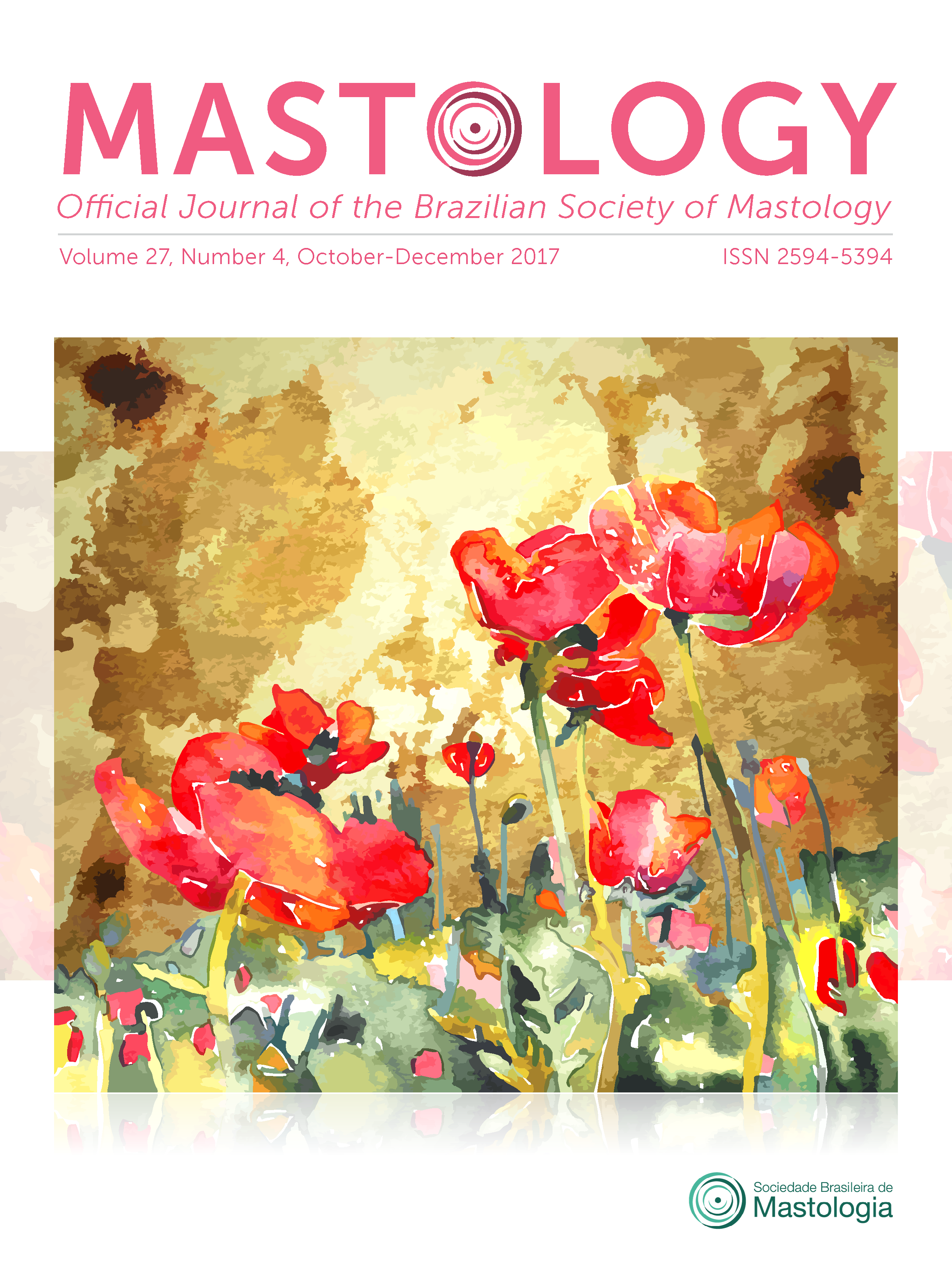PATIENT SELECTION AND TRANSVERSE RECTUS ABDOMINIS MYOCUTANEOUS FLAP COMPLICATIONS
A LITERATURE REVIEW
Keywords:
Myocutaneous flap, breastAbstract
Introduction: Breast cancer is the most prevalent malignant neoplasm in women. Due to delayed diagnosis, a modified radical mastectomy is the surgical treatment of choice for a large proportion of patients with the disease. Breast reconstruction with myocutaneous flaps is the technique that offers the best long-term results. The TRAM (transverse rectus abdominis myocutaneous) technique has been improved in the last 30 years, and its main advantage is its use of large volumes, which gives the new breast contour and a more natural consistency. Objective: Review the literature on the reconstruction technique with the TRAM flap, focusing on technique, patient selection and the main complications. Results: The main indications regarding reconstruction with TRAM refer to cases with extensive defects after immediate or delayed mastectomy, or when there are major consequences from radiotherapy or failure in other reconstructions. Strict criteria must be adopted in the selection of these patients, especially with regard to their comorbidities. The proper selection of patients can reduce a series of complications arising from the method. Conclusion: TRAM is an excellent option for immediate or delayed breast reconstruction as long as the patients are well selected. It eliminates (or at least reduces) the need for implants and their possible implications and additionally gives a more natural format to the reconstructed breast by accompanying the patient’s weight fluctuations. However, this technique is not free of complications, especially with regard to donor areas and the patient’s need for longer surgical and recovery time.
Downloads
References
Oliveira RR, Morais SS, Sarian LO. Efeitos da reconstrução mamária imediata sobre a qualidade de vida de mulheres mastectomizadas. Rev Bras Ginecol Obstet. 2010;32(12):602-8.
Oliveira Junior FC, Mélega JM, Pinheiro AS, Pereira RF. Reconstrução mamária total: técnicas e complicações. Rev Bras Cir Plást. 2010;25(suppl.1):62.
Albornoz CR, Bach PB, Mehrara BJ, Disa JJ, Pusic AL, McCarthy CM, et al. A paradigm shift in U.S. Breast reconstruction: increasing implant rates. Plast Reconstr Surg. 2013;131(1):15-23.
Nano MT, Gill PG, Kollias J, Bochner MA, Malycha P, Winefield HR. Psychological impact and cosmetic outcome of surgical breast cancer strategies. ANZ J Surg. 2005;75(11):940-7.
Atisha D, Alderman AK, Lowery JC, Kuhn LE, Davis J, Wilkins EG. Prospective analysis of long-term psychosocial outcomes in breast reconstruction: two-year postoperative results from the Michigan Breast Reconstruction Outcomes Study. Ann Surg. 2008;247(6):1019-28.
Munhoz AM, Duarte G, Ishida L, Cunha M, Ferreira MC. Reconstrução mamária pós-mastectomia com tecido autógeno – Avaliação comparativa de resultados e complicações. Rev Ginecol Obstet. 2002;13:60-6.
De Lorenzi F, Brenelli F, Thomazini MV. Reconstrução mamária com retalhos miocutâneos. In: Boff RA, Carli AC, Brenelli H, Brenelli FP, Carli LS, Sauer FZ, et al. Compêndio de Mastologia: Abordagem multidisciplinar. Caxias do Sul: Lorigraf; 2015. p.567-80
Petit J, Rietjens M, Garusi C. Breast reconstructive techniques in cancer patients: which ones, when to apply, which immediate and long term risks? Crit Rev Oncol Hematol. 2001;38:231-9.
Hu E, Alderman AK. Breast reconstruction. Surg Clin North Am. 2007;87:453-67.
Mandrekas AD, Zambacos GJ, Zervoudis S. Tram flap breast reconstruction and weight fluctuations: it is alive! Plast Reconstr Surg. 2003;112:696-7.
Kroll SS, Baldwin B. A comparison of outcomes using three different methods of breast reconstruction. Plast Reconstr Surg. 1992;90:455-62.
Drever JM. The epigastric island flap. Plast Reconstr Surg. 1977;59(3):343-6.
Holmström H. The free abdominoplasty flap and its use in breast reconstruction. An experimental study and clinical case report. Scand J Plast Reconstr Surg. 1979;13(3):423-7 .
Robbins TH. Rectus abdominis myocutaneous flap for breast reconstruction. Aust N Z J Surg. 1979;49(5):527-30.
Hartrampf CR, Scheflan M, Black PW. Breast Reconstruction with a Transverse Abdominal Island Flap. Plast Reconstr Surg. 1982;69:216-25.
Munhoz AM, Ferreira MC. Reconstrução Mamária com Microcirurgia. In: Pinotti JA, ed. Tratado de Ginecologia. São Paulo: Revinter; 2004.
Brenelli F, Urban C, Frasson R, Frasson A. Reconstrução mamária com retalhos miocutâneos. In: Frasson A, Novita G, Millen E, Zerwes F, Brenelli F, Urban C, et al. Doenças da Mama: guia de bolso baseado em evidências. São Paulo: Atheneu; 2013. p.277-83.
Parker PA, Youssef A, Walker S, Basen-Engquist K, Cohen L, Gritz ER, et al. Short-term and long-term psychosocial adjustment and quality of life in women undergoing different surgical procedures for breast cancer. Ann Surg Oncol. 2007;14:3078-89.
Nahabedian MY, Momen B. Lower abdominal bulge after deep inferior epigastric perforator flap (DIEP) breast reconstruction. Ann Plast Surg. 2005;54:124-9.
Holm C, Mayr M, Höfter E, Ninkovic M. Perfusion zones of the DIEP flap revisited: a clinical study. Plast Reconstr Surg. 2006;117(1):37-43.
Fernandéz-Frias AM, Aguilar J, Sánchez JA, Merck B, Piñero A, Calpena R. Immediate reconstruction after mastectomy for breast cancer: which factors affects its course and final outcome? J Am College Surg. 2009;208(1):126-33.
Chang DW, Reece GP, Wang B, Robb GL, Miller MJ, Evans GR, et al. Effect of smoking on complications in patients undergoing free TRAM flap breast reconstruction. Plastic Reconstructive Surg. 2000;105:2374-80.
Eberlein TJ, Crespo LD, Smith TL, Hergrueter CA, Douville L, Eriksson E. Prospective evaluation of immediate reconstruction after mastectomy. Ann Surg. 1993;218:29-36.
Djohan R, Gage E, Bernard S. Breast reconstruction options following mastectomy. Cleve Clin J Med. 2008;75(Suppl 1):S17-23.
Downloads
Published
How to Cite
Issue
Section
License
Copyright (c) 2017 Raissa Cruz Oliveira, Douglas de Miranda Pires, Carolina Nazareth Valadares, Guilherme Junqueira Souza, Mariana dos Santos Nascimento, Ana Carolina Guglielmelli Mendonça

This work is licensed under a Creative Commons Attribution 4.0 International License.







